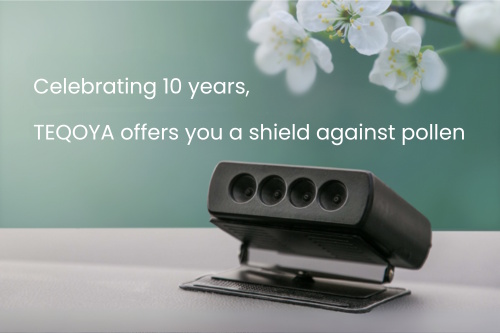Indoor Air Pollution - Fighting Microorganisms
Microorganisms are one of the first threats to the quality of our indoor air. Their proliferation can have adverse effects on our health: respiratory and ocular problems, hypersensitization reactions, etc.
To guard against this, it is essential to know how to identify the sources and adopt the right actions on a daily basis.
1. Fight the mould

Molds are formidable micro-organisms.These are microscopic fungi that grow in hot and humid places: the bathroom, the kitchen, the cellar ... A recent study of the Quality Observatory of Indoor Air (OQAI) reveals that 37% of dwellings have microorganisms in this form. Warning: 64% of contaminations are hidden during a simple visual examination.
Moulds reproduce by releasing toxins and volatile substances into the indoor air in large quantities. These mold spores are inhaled by humans at the same time as pollen, dust and other fine particles and ultrafine. They are likely to cause pulmonary or ENT respiratory symptoms, rhinoconjunctivitis, sinusitis.
Some tips:
- Maintain a moisture content of 40 to 60% and an indoor air temperature of 18 to 22 degrees.
- Watch for the appearance of green or blackish stains on walls, floors and ceilings, hot and humid rooms (bathrooms, kitchens, cellars, etc.)
- If you have mould, pass on a sponge soaked in bleach and let it work for a day. Then, wash off the contaminated surface.
2. Stop vivid the proliferation of bacteria and viruses

Bacteria are well-known microorganisms . These are tiny single-celled organisms that are about one micron in size. In general, the air inside buildings has a higher level of bacteria than outside air. These are much more prevalent in winter than in summer, because of the lack of aeration of housing.
Viruses are less problematic than bacteria. The transmission of these microorganisms - for example, colds or flu - occurs near or in contact with an infected host. The viruses do not survive long in suspension in the air.
Some tips, however, to avoid them:
- Avoid moisture : ventilate or use a dehumidifier if necessary.
- Limit dust accumulation in the heating, ventilation and air conditioning system in your home.
- Remember to ventilate your home, even in winter.
- In addition to the regular ventilation of the housing, a suitable air purifier is an effective way to eliminate bacteria and viruses in indoor air.

3. Fight against mites
Mites - small microscopic animals of the spider family - are added to the list of microorganisms . They like bedding, fabric sofas and armchairs, carpets, curtains, carpets, etc. They feed of textile fibers and dander of human skin. Their excrement and debris of shells may contain allergens that can be found in the air in the form of microparticles (read on!).
To avoid them:
- Avoid humidity and do not overheat your home (22 ° degrees maximum).
- Avoid textile fabrics (sofas and armchairs in fabrics, carpets, curtains, carpets ...).
- Use full mite covers for bedding, slatted baskets .
- Vacuum your home regularly.
4.Limit the presence of allergens
Like mold and pets, insects (cockroaches), mites and plants emit allergens. These microscopic agents can be the source of violent reactions of the immune system (allergies) after contact, ingestion or inhalation. They can cause rhinitis, difficulty breathing, infection of the eyes, eye disorders.
Animal allergens

Allergies due to animals occur mainly in winter. The house is closed, and the animal stays in the house, polluting the indoor air.
- Brush and wash your pet regularly.
- Forbid him access to certain rooms.
- Vacuum several times a week.
Beware of pollen!

The return of spring causes the flowering and therefore the diffusion of pollen in the air. They can penetrate inside the houses by the ventilation system and by infiltration (windows, doors, chimneys). Especially, pollens and pollution form a dangerous cocktail! Pollution (for example ozone) acts on the structure of pollens and reinforces their allergenicity. It is therefore essential to limit the proliferation of pollen in the indoor air.
- Monitor pollution and pollen peaks at the National Aerobiological Monitoring Network site.
- Be sure to renew the air inside your home , preferably in the morning and evening.
- Beware of some houseplants , which disseminate allergenic pollens in the dwelling.
- Change clothes and wash your hair more frequently, because pollen cling to it.
- Dry your laundry indoors rather than outdoors.
An air purifier can help you better fight spring allergies. TEQOYA air purifiers, easy to use and quiet, are the most suitable.
Information on air quality and news from TEQOYA
How does an air ionizer work?
#Essential
Natural environments are rich in negative ions. This is precisely the principle on which the air ionizer is based on. However, do you know how this technology manages to capture the pollution particles contained in the indoor air to purify your home?
Are air purifiers effective against viruses, especially the coronavirus COVID-19
#Virus and microorganismes #L'essentiel
In December 2019, a respiratory virus of the Coronavirus family appeared in the Wuhan region of China and has now spread to all continents.
What is eco-responsibility?
#Essential
Purifying indoor air while protecting your health and the planet is possible! Say goodbye to filters and make way for negative ions: choose an eco-responsible air purifier that will easily reduce energy and resource consumption.

